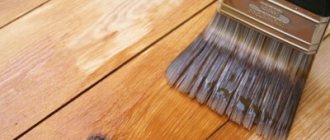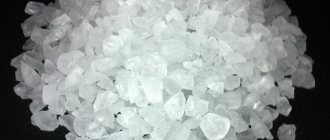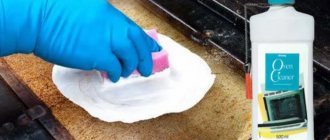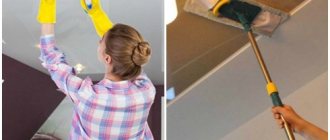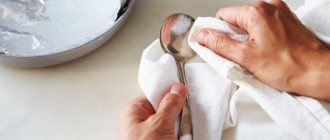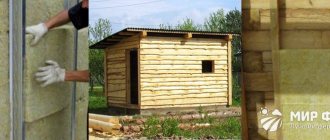Home Home and cottage Cleaning and care
Cleaning the hood filter is a mandatory procedure that must take place at regular intervals. The frequency depends on the load placed on the hood. In industrial premises, restaurant kitchens and cafes, hoods operate constantly; they purify large air flows. In this case, you need to resort to cleaning more often.
If we are talking about public catering establishments, then special control bodies must conduct preventive inspections of such equipment. If the filter is found to be so clogged that it is no longer doing its job, the establishment may be issued a fine.
To clean the filter, it is not necessary to contact a paid specialist. You can do this yourself. The main thing is to figure out which filter is installed. Its different types are cleaned in different ways.
If the hood is under heavy load, the filter should be cleaned at least once a month.
Types of filters and features of their cleaning
The design of the hood, no matter what its model, remains the same: motor, control panel, catch plane and filter. The latter are divided into the following main types:
- Grease-catching.
- Coal.
The first type is designed to clean the air flow from fatty particles. It helps the hood not to become coated inside with a layer of oil suspension, which can lead to difficulties in operation and failure of the equipment.
Grease filters are either disposable or reusable. The former cannot be cleaned; they are thrown away as soon as they become clogged.
Reusable filters can be cleaned yourself and it won't take much time. They are made of a metal frame with a mesh grid and are durable, reliable and resistant to all external influences.
The mesh element of such a filter is made of foil and has separate cells. They are necessary to change the directions of air flows.
They are made of stainless steel, galvanized metal or aluminum. Cleaning is very simple - the metal cassette is removed and washed with a sponge. If the hood has several cassettes, then you need to remove each one in turn.
The carbon filter absorbs the air, cleans it and sends it back into the room. The peculiarity of this type is that the filter not only purifies the air, but also eliminates odors.
It looks like a rectangular plastic cassette with a mesh containing coal inside. It is this that allows you to efficiently filter the air and eliminate odors.
Such filters are most often purchased additionally and installed together with grease-absorbing filters. The downside is that they cannot be cleaned. Every 3 - 4 months they need to be replaced with new ones.
Also, installing a carbon filter can lead to a decrease in the capacity of the hood. Therefore, it is important to ensure that the filters do not become clogged, otherwise the equipment will completely fail.
It is best to purchase a stainless steel filter: it is more durable, easy to clean and filters the air.
How to quickly and effectively clean grease from a kitchen hood?
It is impossible to imagine a modern kitchen without a hood. This is not a decorative item at all, but an important household appliance. It is installed directly above the stove or hob and is designed to suck in air mixed with the odors of cooking food.
Very often housewives forget to turn on the hood or consider it unnecessary. However, you must understand that during cooking, small particles of soot and fat settle on the walls and furniture. Over time, the entire kitchen becomes covered with a sticky, dirty yellow coating, and not only spoils the appearance of the decor, but also the furniture.
If the hood is used constantly, then it requires regular and careful maintenance.
From time to time it becomes clogged with grease and layers of dirt, and its performance decreases noticeably. In this case, you need to replace the filter, or if it is a stainless steel mesh, then clean it. This is a troublesome and dirty business. It is recommended to wash the hood 1-2 times a month, otherwise it is very difficult to get rid of the greasy layers.
Let's find out further what grease filters are used in different types of hoods and what to do with them: replace them with a new one or clean them yourself?
What filters are installed in hoods?
Grease traps
Any kitchen air purifier must have a grease filter. It is designed to clean the air flow passing through the device from small suspended fatty particles. If it had not been there, then less than a month would have passed before the internal surfaces of the hood, including the engine, were covered with a layer of oil suspension.
The grease filter can be disposable or reusable - it is clear that the latter type is better and more practical. Disposable models are made from padding polyester, acrylic or non-woven fabric and are most often installed in budget flat-type structures. Such “rugs” made of synthetic fabrics are thrown away as soon as they become dirty.
Disposable fat “catchers” cannot be washed; when washed, they lose all their properties. That's why they are disposable.
Using an “updated” product in this way is fraught with engine damage.
Grease filter
But a metal grease filter will last as long as the hood itself - it is distinguished by its quality, safety, reliability and durability. Such designs are better because they do not need to be replaced, but only require periodic washing.
A traditional grease filter is a cassette in the form of a metal frame and a mesh element made of foil (in the form of a lattice or with perforation). The perforation here can be uniform or asymmetrical, and the provided cells are necessary to change the direction of air flow. This allows fat particles to be retained on the surface.
The metal grease filter can be made of aluminum, galvanized steel or thin stainless steel. In high-quality technology, aluminum is additionally anodized, which protects the product from oxidation. Such structures can have several layers or be made in the form of several modules.
Two or three separate cassettes are easier to maintain - they are easy to remove, wash and return to their place.
A stainless steel grease filter is considered better than an aluminum one, since this material has a longer service life. In addition, products of this type purify the air more effectively.
Coal
If we are talking about recirculation models that purify the air in the kitchen and send it back into the room, then a carbon filter for the hood is mandatory. Indeed, in such models it is important not only to remove soot and grease, but also to cleanse the air of foreign odors.
The installation of a coal “catcher” is provided behind the grease catcher. This element is based on a high-quality adsorbent, activated carbon. It perfectly absorbs all odors.
It should be remembered that in the recirculation mode, the throughput of the hood drops by 15-20%, and the installation of an absorbent product reduces it even more. If the carbon adsorbent accumulates contaminants, then the air through it will pass worse and worse.
A carbon filter for hoods is often not included in the basic package and must be purchased additionally. In addition, this is a replaceable element that will have to be purchased regularly as it wears out.
Externally, such an element may look like a rectangular cassette or a circle. The body of the product is plastic, and the coal is held in place by a special mesh. Activated carbon is here in the form of powder or granules.
The larger the total area of absorbing particles, the better the “catcher” works.
Due to coal compacted in one place, the efficiency of the hood decreases. The process for replacing the carbon filter is as follows:
- The hood is disconnected from the network (this is necessary for safety);
- The anti-grease filter is removable;
- The carbon filter is removed from the cassette;
- A new carbon filter is being installed - a click indicates that the operation was carried out correctly;
- The hood is turned on and checked for vibrations and extraneous noise, which could be caused by improper installation of the filter elements.
Source: kitchendecorium.ru
How often do you need to change the carbon filter? If you choose a hood that operates in recirculation mode, the requirements for air purification increase. After all, you not only need to collect soot and grease, you need to clean the air from the smallest contaminants that manifest themselves as odors. This is a rather delicate job, which carbon filters for hoods can handle.
They are located behind the grease filters. The basis of the carbon filter, as you might guess from its name, is activated carbon - a well-known absorbent. It perfectly absorbs and reliably retains harmful substances inside. The only drawback is that these filters need to be changed quite often, and they cost from 250 to 2500 rubles, depending on the quality and manufacturer.
Kuppersberg carbon filter is one of the best models on the market. The performance of the entire unit depends on the quality of the carbon filter. In recirculation mode, the filter capacity decreases by approximately 20%. This occurs because the movement of air inside the filter is hampered.
Carbon filters vary in density, and the more it is filled, the slower the air passes through it.
Therefore, do not forget to change cartridges in a timely manner.
On average, carbon filters for hoods last 3-4 months, but different manufacturers give different recommendations regarding the service life. Thus, Elica filters are recommended to be changed every 2 months. Cartridges from Elikor, Jetair - once every 3-4 months, depending on the frequency of use of the hood.
After all, you can turn it on every other day for half an hour, or every day for three hours. Falmec filters last 4 months, Fabriano lasts from 4 to 6 months, Krona lasts from 6 to 12 months, Gaggenau should be changed twice a year, and the Bosch filter should be changed once a year. As a rule, additional carbon filters for hoods are not included in the package of the device.
If you leave your hood on for an additional 5 minutes after each use, you can extend the life of the carbon filter. This way, the remaining moisture is removed from it, and the coal will not cake and will retain its high adsorbing capacity.
Source: kitchenguide.su
Where to start cleaning?
In order not to spoil an expensive device, it is recommended that you first study the instructions for it, which give clear instructions on how to wash the device. Modern hoods may have their own cleaning system, which will simplify cleaning procedures.
Most often, the principles of washing and cleaning a kitchen hood boil down to the following steps:
- For your safety and the safety of the appliance, turn off the power by unplugging it from the outlet.
- To get to the inside of the hood you need to remove the front panel.
- The design of the hood contains a filter that resembles a regular fine-grained mesh. It must be removed and soaked in water with detergent or soap solution. As the grease and dirt soak, they can be easily removed.
- Continuing to disassemble the structure, remove the pipe that discharges air into the ventilation hole. It also needs to be washed, cleaned of cobwebs and grease, and prepared for further use.
Most often it is secured with latches, but if necessary, unscrew the mounting bolts. Try to put the bolts together so that you can assemble the device later.
The outer panel must be washed using detergents; when removed, it will be much easier to clean it from grease than when attached to the hood.
Now that all the parts have been removed, you can move directly to the hood itself. There are usually drops of frozen fat and dirt on its surface on all sides. Using detergents, it is necessary to wash off all dirt, remove soot and grease, and prepare the device for assembly.
As soon as you have managed to wash the filter, pipe, outer panel and the hood itself from grease, reassemble the device and prepare it for further work. This method of washing is applicable to heavily contaminated air exhaust devices, but if the contamination is not of such a horrific nature, then you can limit yourself to washing the filter.
Source: ubirai.ru
Cleaning the filter
There are many ways to wash grease from the filter (grille) of the hood:
- automated;
- steam;
- boiling;
- ecological;
- suffocating;
- chemical;
- bleaching;
- risky.
Automated
The easiest way to wash grease from a hood is to put the hood filter (grid) in the dishwasher, pour in the appropriate detergent and turn on the unit at the minimum temperature.
Steam
This method is similar to the automated option. This will require a steam cleaner. The equipment is expensive, but it makes life very easy in the field of any cleaning. Water is poured into the steam cleaner, it is plugged in, and then just move it with your hands... The steam cleaner usually comes with several attachments and special napkins. Their use is described in the instructions for the unit.
Boiling
After boiling, the water in the pan will have a yellowish tint. If the dirt has been partially removed, we recommend repeating the operation again.
Grandma's old way! Many people remember how in Soviet times, mother or grandmother would put metal kitchen utensils in a huge pan called “evavarka” and cook for several hours in a soapy solution. The plot is the same:
- Grate laundry soap (half a bar);
- Place grated soap, 50 grams of salt and the same amount of soda in a large saucepan;
- Lower the filter (grid) of the hood into this solution and boil for a couple of hours;
- Let cool;
- Remove and rinse under running water.
Ecological
A fairly easy and inexpensive way to clean the hood from grease if you have a large pan in the house that can accommodate the hood filter (grid). Little effort and time will be spent:
- Heat water to boiling;
- Slowly, in small portions, pour 50 grams of regular soda into boiling water;
- Immerse the filter (grid) of the hood;
- Boil, depending on the degree of contamination, for 5 minutes.
Suffocating
The result of the work is a clean hood in almost original condition. The same labor-intensive and inexpensive method for cleaning the hood from grease involves using ammonia in the presence of a large saucepan.
Everything is done just as easily as in the previous version, the only problem is the “aroma” that eats away at the eyes. This method will help if the stains were severe and you were unable to wash off the grease with soda:
- Take four liters of water and boil;
- Open the windows and wear a respirator to protect your respiratory system;
- Remove the pan from the heat;
- Pour 100 ml of ammonia into the pan;
- Immerse the hood filter (grid) for a few minutes.
Chemical
Our stores are filled with a variety of household chemicals. This method cannot be called cheap, but it is quite fast. To clean the hood from grease, you can use:
- foam for cleaning ovens, barbecues, grills TOPCleanner;
- Amway oven cleaner;
- gel for Sanita slabs;
- Bagi Shumanit cleaning agent.
Bleaching
You will have to put in the effort and time, but without investing a lot of money. You will need liquid whitener, a toothbrush and rubber gloves.
Stages of work:
- Wear gloves;
- Wet the surface to be cleaned;
- Apply white using a toothbrush;
- Leave for 10 minutes;
- Rinse under running water.
Risky
There are products for cleaning water drains and sewer pipes. These products can very well remove grease from the hood, but their use contributes to the destruction of the metal. This is the risk - being left without a hood! The process is quite simple:
- Place the filter (grid) of the hood horizontally in a stainless container (you will need something in the shape of a box!);
- Wear rubber gloves;
- If the sewer pipe cleaner is liquid, then apply it to the filter (grid). If the product is in granules, then pour it on top of the filter over the entire surface;
- Pour hot water – it will hiss and bubble;
- Leave for 20 minutes;
- Rinse with running water;
- Pour the used solution into the toilet.
Source: kitchenremont.ru
How to clean grease from a range hood motor?
With active long-term use of the hood and irregular maintenance, fat particles settle on the entire internal surface, not excluding the engine. To clean this part, it is better to invite a specialist who will correctly disconnect the motor and wash it in a special solution. At home, it is better to limit yourself to mechanical cleaning of the fat layer and wiping accessible parts with alcohol.
Source: kakpostirat.com
kachestvolife.club
Preparatory work before the cleaning procedure
Before you begin the cleaning process itself, you need to do some preparatory work. The first step is to disconnect the equipment from the network. After this, you need to disassemble the hood so that you can get to the filter.
Dismantling occurs in the following sequence:
- The hood cover is removed. To do this, you need to press the latches and pull it out of the grooves.
- The filter cassette is carefully removed.
- The pipe that connects the hood and the vent is dismantled. This is also necessary to clean it of dirt and grease.
- The air filter is removed.
- The appearance of the hood body is analyzed. If it is dirty, it also needs to be washed.
Each stage must be completed slowly. It is advisable to soak the pipe and filter in a container of water for a while. To do this, you can use dishwashing detergent or liquid soap. Before you start cleaning the air filter, you need to make sure that it can be subjected to this procedure. To do this, you should read the instructions for the hood.
Cleaning the body of this kitchen appliance is also not difficult. You can use simple kitchen soap for this. After the surface is washed, you need to wipe it dry. This will avoid streaks and prevent metal elements from becoming rusty. You can experiment directly with cleaning the filter, because there are several effective methods. You can choose based on your preferences and the means at hand.
It is important to dry all parts before reinstalling it in reverse order.
How to prepare the hood for cleaning?
In order to figure out how to clean a kitchen hood, you should understand the sequence of actions. All the basic recommendations that allow you to independently remove traces of grease from all surfaces of the hood are given in the corresponding instructions for this product.
There will be a diagram of the assembly and disassembly of the structure, since the main activities related to the removal of old fat at home will be carried out precisely inside this device.
- To clean the mesh in the hood, you must first protect yourself by disconnecting the structure from the power supply. Otherwise, it is strictly forbidden to disassemble it, especially if you do not touch the motor or try to wet clean it.
- Directly on the hood itself there should be a diagram on how to remove the grille from the hood. It is usually held in place by snap-off clips. The carbon filter in the hood is usually hidden behind this grille. As a rule, this is where the bulk of contaminants accumulate. In order not to think about how to quickly clean it from dirt, such a filter can simply be replaced - such products are not too expensive.
- When cleaning the kitchen hood from dirt, you should remember that it is connected to the ventilation vent using a profile, round or corrugated pipe. It also accumulates a certain amount of soot and grease during direct operation. It is most convenient to wash a profile pipe if it is not too long. A longer structure should be round in cross-section - this will not only make it easier to clean, but also slow down the accumulation of fat.
- It is not so difficult to clean the kitchen hood filter from grease, but it will have to be removed. This is not too difficult to do, and if you know certain tricks, then the cleaning process itself will be quite simple and will take a minimum amount of free time.
- Usually no one removes the body of the structure; it is washed both outside and inside.
- At the last stage, you should assemble the hood above the stove and connect it to the electrical network.
There are special hoods on sale that have turboair type filters installed - their design does not mean that these elements can be cleaned; you will have to install new products instead. To find out whether it is permissible to clean the hood from grease at home, you should carefully read the instructions.
Clean the filter using traditional methods: is it possible?
When starting the cleaning process, you can use specialized detergents: gels, powders, detergents, etc. But simple, and most importantly cheap, improvised means will help you cope with the task. They will not only save money, but are also less aggressive chemically. You won't have to worry about the skin of your hands when cleaning them.
One of the most inexpensive ways to clean the filter and other elements of the hood is simple soap, liquid soap or dishwashing detergent. To do this, you need to take the filter, grille and mesh and soak them in a container with soapy water.
To obtain this solution, you need to maintain the proportion - 4 portions of water to one portion of detergent. You need to leave the parts for 30 - 60 minutes. After this, you should pour boiling water over them and thoroughly clean them with a brush. It is important to choose a soft brush so that it does not leave scratches on the surface. You can try it on a small area, and then clean the entire filter and other elements. Parts must be dried before reinstalling, or wiped with a soft cloth.
Baking soda will also help remove dirt and grease. There are two options for using it:
- boil the filter and hood parts in a soda solution;
- make a paste of baking soda and water and apply it to the elements.
The second option will not cause any difficulties, but to implement the first you need to take a large container of water and put it on fire. Gradually add baking soda and stir it so that it dissolves faster. When the water boils, place the filter and the rest of the hood elements into it. Boil for 20 - 30 minutes. This method will allow you to get rid of even old dirt and grease and will not hurt your pocket.
Simple laundry soap can also help. You need to grate half or one whole soap into a container with water. Stir to create rich soapy water. After this, you need to put the filter in it and leave it for several hours. Some of the dirt may come off on its own, but the rest needs to be removed with a sponge or scraper.
Vinegar is an effective filter cleaner. It is best to use it in concentrated form. The algorithm is as follows:
- apply vinegar to the cloth;
- rub the filter and leave for 15 - 20 minutes;
- Remove dirt with a clean cloth and rinse the element with running water.
When cleaning in this way, you only need to wear gloves. Otherwise, you can harm your skin, get allergies or burns. If the filter is not very dirty, the vinegar can be diluted with water. The ideal proportion is 2 portions of vinegar, one portion of water.
Can remove dirt and lemon juice. But this option is quite expensive, because you will need a lot of lemons. Citric acid can replace it. You need to make a paste out of it and apply the mixture to the hood parts and filter. Wait 20 - 30 minutes and rinse them thoroughly with water. You can use a sponge.
These methods are very inexpensive and accessible. But they are not comparable in strength to chemicals. Therefore, if the contamination was not removed the first time, you can try again.
Cleaning the filter is a painstaking job that requires perseverance. Small cells in the grid do not allow you to quickly complete the task. It is important to take your time and thoroughly wash every centimeter of the filter.
You should only use a plastic scraper, because a metal one can scratch the surface.
Where to start cleaning?
In order not to spoil an expensive device, it is recommended that you first study the instructions for it, which give clear instructions on how to wash the device. Modern hoods may have their own cleaning system, which will simplify cleaning procedures.
Most often, the principles of washing and cleaning a kitchen hood boil down to the following steps:
- For your safety and the safety of the appliance, turn off the power by unplugging it from the outlet.
- To get to the inside of the hood you need to remove the front panel.
- The design of the hood contains a filter that resembles a regular fine-grained mesh. It must be removed and soaked in water with detergent or soap solution. As the grease and dirt soak, they can be easily removed.
- Continuing to disassemble the structure, remove the pipe that discharges air into the ventilation hole. It also needs to be washed, cleaned of cobwebs and grease, and prepared for further use.
Most often it is secured with latches, but if necessary, unscrew the mounting bolts. Try to put the bolts together so that you can assemble the device later.
The outer panel must be washed using detergents; when removed, it will be much easier to clean it from grease than when attached to the hood.
Now that all the parts have been removed, you can move directly to the hood itself. There are usually drops of frozen fat and dirt on its surface on all sides. Using detergents, it is necessary to wash off all dirt, remove soot and grease, and prepare the device for assembly.
As soon as you have managed to wash the filter, pipe, outer panel and the hood itself from grease, reassemble the device and prepare it for further work. This method of washing is applicable to heavily contaminated air exhaust devices, but if the contamination is not of such a horrific nature, then you can limit yourself to washing the filter.
Source: ubirai.ru
Various ways to clean the hood filter
If simple methods do not help rid the hood filter of contaminants, then more complex cleaning methods can be used.
These include:
- Boiling using laundry soap and soda. For this method to work, you need to pour water into the pan, add laundry soap without any additives and 2 tablespoons of soda. The container must be put on fire.
- When the water boils, you should place a filter in it. If it does not fit completely, then you need to boil one side first, and then the other.
- The boiling process should last 5 - 7 minutes, after which the filter should be left in this liquid for several hours.
- Thanks to the influence of temperature and detergents, all contaminants quickly disappear. In this case, you don’t even need to use a sponge or brush.
- At the end of the procedure, you need to rinse the filter with water and dry it well.
Another effective method is to use a drain cleaner. This substance is chemically active, so you need to prepare first and wear gloves. The procedure can be carried out in a sink, if it is stainless, or in a basin. Add the product to the water and stir well. Place the filter in the container. The reaction will be visible immediately - bubbling fountains will begin to appear.
Leave the element for just a few minutes. This will be enough to get rid of dirt and grease. If you overexpose it, the alkali will damage the metal mesh. This option can be considered a last resort when others do not help. The hood filter can be easily cleaned using a drain cleaner. To implement your plan, you need to place the filter on a baking sheet and fill it with water so that it covers the part.
Then you need to sprinkle the product on the filter and observe the reaction. The mixture will begin to foam and gurgle heavily. This will happen for several minutes. Then you need to drain the water into the toilet and rinse the element with water. In order not to overdo it with the amount of powder, you need to read the instructions on the package.
Another way to get rid of dirt is to use dishwasher detergent. You need to take 1 teaspoon of the product and mix it with 4 glasses of warm water. Use a sponge soaked in liquid to thoroughly rinse the filter. The metal mesh must be wiped lengthwise so that there are no streaks left.
Whatever method the owner of the hood uses, the main thing is to start cleaning as quickly as possible, while the dirt is exposed. The longer the filter is dirty, the more difficult it will be to clean it. If the situation is not critical and there is no serious contamination, then plain water with lemon is perfect.
Cleaning the filter
There are many ways to wash grease from the filter (grille) of the hood:
- automated;
- steam;
- boiling;
- ecological;
- suffocating;
- chemical;
- bleaching;
- risky.
Automated
The easiest way to wash grease from a hood is to put the hood filter (grid) in the dishwasher, pour in the appropriate detergent and turn on the unit at the minimum temperature.
Steam
This method is similar to the automated option. This will require a steam cleaner. The equipment is expensive, but it makes life very easy in the field of any cleaning. Water is poured into the steam cleaner, it is plugged in, and then just move it with your hands... The steam cleaner usually comes with several attachments and special napkins. Their use is described in the instructions for the unit.
Boiling
After boiling, the water in the pan will have a yellowish tint. If the dirt has been partially removed, we recommend repeating the operation again.
Grandma's old way! Many people remember how in Soviet times, mother or grandmother would put metal kitchen utensils in a huge pan called “evavarka” and cook for several hours in a soapy solution. The plot is the same:
- Grate laundry soap (half a bar);
- Place grated soap, 50 grams of salt and the same amount of soda in a large saucepan;
- Lower the filter (grid) of the hood into this solution and boil for a couple of hours;
- Let cool;
- Remove and rinse under running water.
Ecological
A fairly easy and inexpensive way to clean the hood from grease if you have a large pan in the house that can accommodate the hood filter (grid). Little effort and time will be spent:
- Heat water to boiling;
- Slowly, in small portions, pour 50 grams of regular soda into boiling water;
- Immerse the filter (grid) of the hood;
- Boil, depending on the degree of contamination, for 5 minutes.
Suffocating
The result of the work is a clean hood in almost original condition. The same labor-intensive and inexpensive method for cleaning the hood from grease involves using ammonia in the presence of a large saucepan.
Everything is done just as easily as in the previous version, the only problem is the “aroma” that eats away at the eyes. This method will help if the stains were severe and you were unable to wash off the grease with soda:
- Take four liters of water and boil;
- Open the windows and wear a respirator to protect your respiratory system;
- Remove the pan from the heat;
- Pour 100 ml of ammonia into the pan;
- Immerse the hood filter (grid) for a few minutes.
Chemical
Our stores are filled with a variety of household chemicals. This method cannot be called cheap, but it is quite fast. To clean the hood from grease, you can use:
- foam for cleaning ovens, barbecues, grills TOPCleanner;
- Amway oven cleaner;
- gel for Sanita slabs;
- Bagi Shumanit cleaning agent.
Bleaching
You will have to put in the effort and time, but without investing a lot of money. You will need liquid whitener, a toothbrush and rubber gloves.
Stages of work:
- Wear gloves;
- Wet the surface to be cleaned;
- Apply white using a toothbrush;
- Leave for 10 minutes;
- Rinse under running water.
Risky
There are products for cleaning water drains and sewer pipes. These products can very well remove grease from the hood, but their use contributes to the destruction of the metal. This is the risk - being left without a hood! The process is quite simple:
- Place the filter (grid) of the hood horizontally in a stainless container (you will need something in the shape of a box!);
- Wear rubber gloves;
- If the sewer pipe cleaner is liquid, then apply it to the filter (grid). If the product is in granules, then pour it on top of the filter over the entire surface;
- Pour hot water – it will hiss and bubble;
- Leave for 20 minutes;
- Rinse with running water;
- Pour the used solution into the toilet.
How often should you clean the hood filter?
The procedure must be performed based on two factors:
- intensity of device operation;
- availability of free time.
The more often the hood is used, the more often it needs to be washed. The front of its work is also of great importance. In large production facilities, in rooms where there are large crowds of people, in the kitchens of restaurants and cafes, the hood works almost around the clock. Filters clog faster and over time the efficiency of the equipment decreases. If you ignore this point, the hood will one day stop working completely.
Availability of free time also plays a big role. If you have the opportunity and desire, you can clean the filter once a month. Comprehensive cleaning should be carried out at least once a quarter. This involves cleaning the filter, pipe and hood body. The grate is an element that is located in an accessible place, so it can be washed more often. It is enough to periodically pass over it with a damp sponge and there will be much less dirt.
One trick you can use to save time and effort is to use a dishwasher. Then the filter can be cleaned at least every week.
Despite the accessibility and attractiveness of the method, it should be remembered that there should be moderation in everything. Often, manipulating the filter can cause it to wear out faster and will soon have to be replaced with a new one. This can lead to considerable waste, because high-quality hoods have expensive filters installed.
Large enterprises and restaurants keep a special log where they record when the filter and the hood as a whole were last cleaned. This principle of control can also be carried out at home, so as not to overdo it or, conversely, to prevent excessive pollution.
